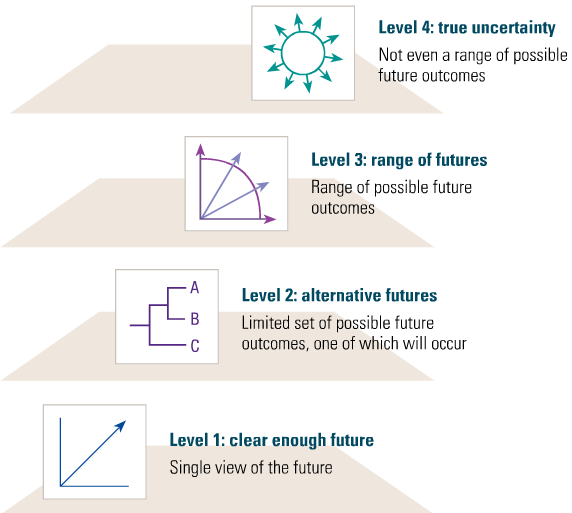Business environments are described or analysed in various ways based on disparate important dimensions. However, the concept of turbulence is ambiguous. This confusion touches on the varying orientations in studying organisational environments and the diverse methods that are used to measure it. Environmental turbulence underscores the extent of change and degree of complexity in a business environment. Changes in technology, statutory regulations, or environmental factors are some of the examples that constitute environmental turbulence. Therefore, a turbulent environment is dynamic, expanding, unpredictable, and fluctuating. In addition, such an environment displays high levels of interconnectedness with the business. Turbulence is a complex interaction of several dimensions that are related to change where some elements dominate others or overlap each other at times. The figure below shows the configuration of the main dimensions of environmental turbulence. 1. Dynamism If the components of the tasks of the environment are highly variable, the business needs Continue reading
Strategic Management Terms
Mergers and Acquisitions (M&A) – Definition, Types, and Process
Mergers and Acquisitions (M&A) are increasingly becoming a novel approach for companies to wade through the competitive pressures of today’s globalized society. The increase of mega-mergers in today’s corporate world demonstrates the entrenchment of such transactions in modern business practices. Definitions of Mergers and Acquisitions “One plus one equals three”. This statement defines the main logic that informs merger and acquisition transactions. This logic stems from the fact that most companies aim to create a bigger shareholder value than the sum of the shareholder value that would ordinarily be realized if two corporate entities merge. The reasoning behind merger and acquisition transactions therefore stems from the fact that there is a greater value when two companies work together, as opposed to two companies working in isolation. Mergers and Acquisitions (M&A) are therefore joint activities where the activities of two or more companies merge to create one common purpose for both Continue reading
Person-Environment Fit – A Theoretical Perspective
Organisational theory is essential in the determination of the appropriate behaviors and management approaches that would yield the success of an organisation both in the short-term and long-term basis. Organisational theory encompasses the study of organisations for the benefit of identifying common themes for the purpose of solving problems, maximizing efficiency and productivity, and meeting the needs of stakeholders. Topics such as environmental perspectives in enhancing organisational development, neoclassical perspectives, and classical perspectives of approaching organisational management are central to the study of organisational theory. From this perspective, organisational theory acts as a complement for studies in human resource coupled with organisational behaviors. Studying organisational behaviors is integral to the derivation of strategies for organisational management that would result to alignment of all organisational workers to common themes, goals, and objectives that spell out the reasons as to why an organisation is established. Without employees, an organisation cannot exist. For Continue reading
Business Risk Management – Meaning, Stages, Benefits and Limitations
Risk is the combination of the probability of an event and its impacts. It is the possibility of an event and its effect that constitute benefits or impediments to success in an undertaking. In an enterprise, identification of a hazard has both a helpful and a harmful aspects. Consequently, both the benefits and threats to the success of business operations are considered in the assessment of risk. When focusing on safety, risk only takes the perspective of negative consequences. As a result, it focuses on the alleviation and avoidance of harm. Threat management is vital in organizations’ tactical management. It entails a process where organizations tackle the risks connected to their actions with the objective of attaining constant benefit within individual activities and across a range of all actions. Businesses are affected by both interior and exterior factors relating to risks. Some risks can be categorized as external, while others Continue reading
Four Levels of Uncertainty – Strategic Planning Under Uncertainty
Even the most uncertain business environments contain a lot of strategically relevant information. First, it is often possible to identify clear trends, such as market demographics, that can help define potential demand for future products or services. Second, there is usually a host of factors that are currently unknown but that are in fact knowable-that could be known if the right analysis were done. The uncertainty that remains after the best possible analysis has been done is what we call residual uncertainty. Hugh G. Courtney, Jane Kirkland, and S. Patrick Viguerie in their article Strategy Under Uncertainty have developed a useful framework for dealing with various uncertainties in strategy formulation. Four Levels of Uncertainty The authors present four levels of uncertainty: 1) A predictable future, 2) Alternate futures 3) A range of futures 4) True ambiguity. Level 1: Clear Enough/Predictable Future This would apply to situations where sufficiently precise predictions Continue reading
The Role of Intelligence in Strategy Formulation
Strategic management is that ideas and injunctions that enable the organization achieve its objective or long-term target to perform a better performance. The purpose of strategic management is to seek the opportunities for better future of the organization. Generally, good strategic management practices can improve the organization performance and achieve the organization target objectives. The strategies on an organization are made by the management itself to ensure the successful of the organization. The strategic management process consists of three stages which are strategy formulation, strategy implementation and strategy evaluation. Strategy formulation want to ensure that the organization achieve the objectives that they have been made. Strategy formulation includes the decision on what business to conduct, how to allocate the resources, and whether want the business join or enter to international market. Besides, strategy formulation phase includes developing a vision and mission, identifying an organization external opportunities and threats, determining internal Continue reading


